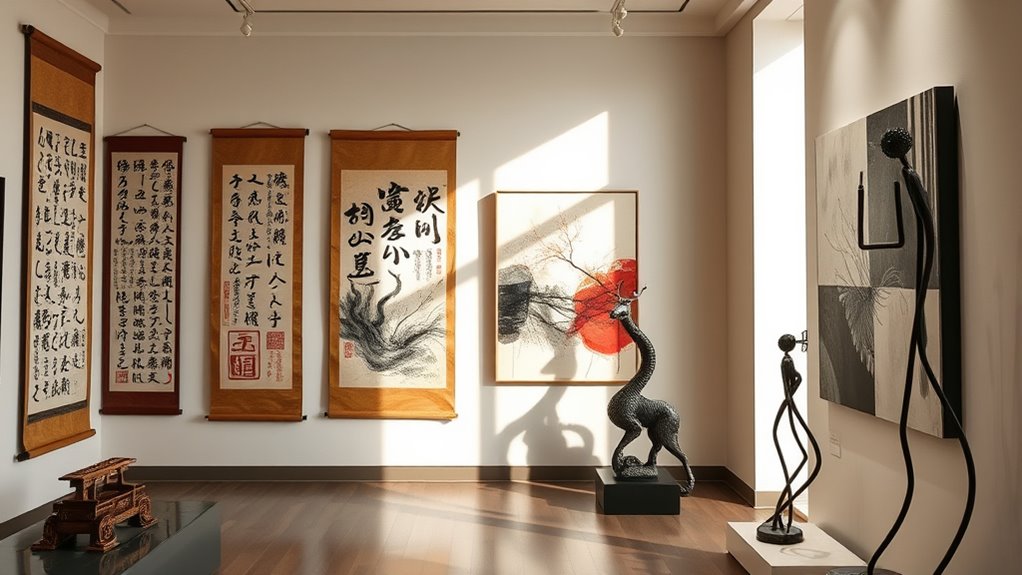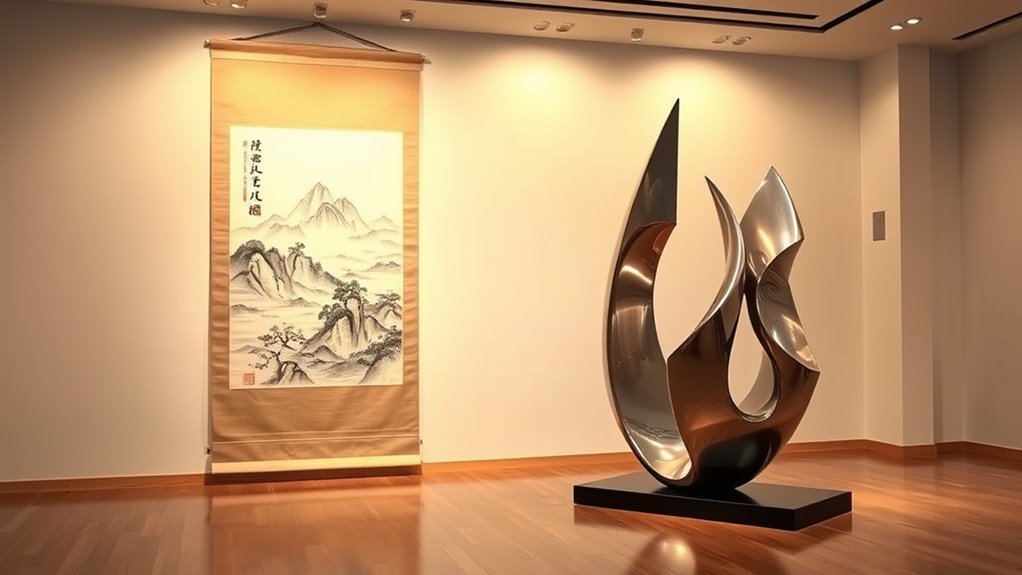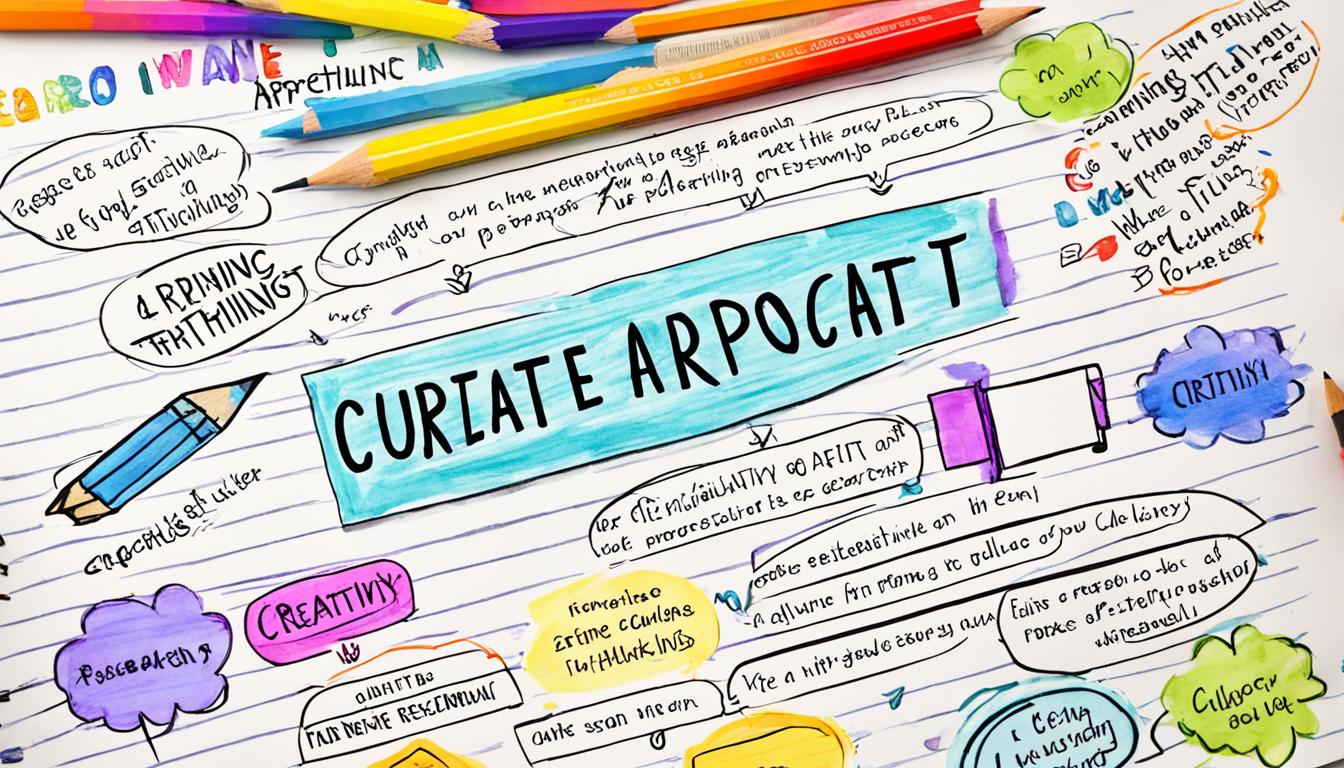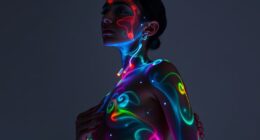Cross-cultural influences between Eastern and Western art inspire each other by blending traditional techniques like Eastern brushstrokes with Western design elements, creating innovative styles that push boundaries. Artists fuse cultural motifs, turning ancient symbols into modern expressions seen in fashion, branding, and visual arts. This exchange encourages ongoing experimentation, enriching both traditions and fostering a global artistic dialogue. Stay curious to discover how these creative overlaps continue to shape vibrant new forms of expression across the world.
Key Takeaways
- Artists blend Eastern calligraphy techniques with Western typography to create innovative visual languages and hybrid art forms.
- Digital platforms enable cross-cultural remixing, fostering experimentation and new artistic expressions.
- Western design and fashion incorporate Asian motifs and brushstroke aesthetics, enriching aesthetic diversity.
- Eastern calligraphy’s meditative process influences Western abstract art and contemporary practices.
- Collaborative exchanges promote ongoing innovation, merging cultural traditions while preserving their unique identities.

Have you ever wondered how different cultures shape the way we think, communicate, and create? When you explore the world of art, you’ll notice how Eastern and Western traditions influence each other in fascinating ways, especially through calligraphy traditions and modern fusion. Calligraphy isn’t just about beautiful writing; it embodies cultural identity, spiritual practice, and artistic expression. In Eastern cultures, like China, Japan, and Korea, calligraphy is revered as a highly disciplined art form, emphasizing brushstrokes, rhythm, and balance. Each stroke carries meaning, and the process is meditative, reflecting a deep connection between the writer and their cultural heritage. Conversely, Western calligraphy, with roots in Latin script, has historically focused on ornate, decorative styles, often integrated into illuminated manuscripts and formal documents. Over time, both traditions have evolved, influencing and blending with each other, giving rise to modern fusion styles that challenge traditional boundaries. The importance of cultural heritage plays a significant role in shaping these artistic practices and their contemporary interpretations.
You can see how calligraphy traditions have influenced contemporary art scenes worldwide. Artists now combine Eastern brush techniques with Western typography to create innovative visual languages. This fusion is more than just stylistic; it’s a dialogue that bridges cultural gaps, fostering an appreciation for diversity. Modern artists experiment with calligraphy, blending traditional brushwork with digital tools, creating hybrid artworks that are both contemporary and rooted in history. The fusion of these styles often results in dynamic compositions that honor heritage while embracing innovation. For example, some artists incorporate Asian calligraphy strokes into graffiti or street art, infusing urban spaces with a sense of cultural depth. Others use digital platforms to remix calligraphic styles, producing vibrant, eclectic pieces that reflect a globalized world. Additionally, the cross-cultural influence of artistic techniques encourages artists to explore new mediums and push creative boundaries.
Furthermore, the cross-cultural exchange of artistic techniques enriches both traditions, encouraging a continuous evolution of style and meaning. This blending of traditions isn’t limited to visual art. It influences design, fashion, and even branding, where cultural motifs are reimagined through a modern lens. You might notice Asian-inspired calligraphy motifs on fashion runways or Western logos that incorporate brushstroke aesthetics. These cross-cultural exchanges create a rich tapestry of influences, inspiring new generations of creators to experiment freely. The ongoing dialogue between Eastern and Western art forms encourages innovation without losing sight of cultural roots. It’s a reminder that art continually evolves through collaboration and exchange, pushing boundaries and expanding your understanding of beauty and expression. When you observe or participate in this blend of traditions, you become part of a global narrative—one where cultural differences enrich and inspire, leading to fresh, exciting artistic landscapes.
Frequently Asked Questions
How Do Eastern and Western Art Philosophies Differ?
When exploring how Eastern and Western art philosophies differ, you notice distinct philosophical distinctions and aesthetic priorities. Eastern art often emphasizes harmony, spirituality, and natural flow, reflecting a holistic worldview. Western art tends to focus on realism, individual expression, and perspective. You see these differences in their approaches to beauty and meaning, shaping how artists create and viewers interpret artworks across cultures.
What Are Some Key Examples of Cultural Exchange in Art History?
Think of art history as a vibrant tapestry woven with threads of cultural exchange and artistic fusion. You see it in the Silk Road, where Chinese porcelain influences European ceramics, or in Japonism, inspiring Impressionists like Monet. The Renaissance’s exposure to Islamic art exemplifies this exchange, blending styles seamlessly. These key examples highlight how cultures intertwine, creating new artistic expressions that enrich our shared creative journey across centuries.
How Has Globalization Impacted Cross-Cultural Artistic Collaborations?
Globalization accelerates cross-cultural artistic collaborations by enabling artists to share ideas and techniques worldwide. You’ll notice fusion techniques blending diverse styles, creating innovative works, while aesthetic convergence emerges as different cultures influence each other’s visual language. This interconnectedness fosters deeper understanding and appreciation, inspiring artists to push boundaries and explore new creative directions. As a result, art becomes a dynamic dialogue that celebrates shared humanity and diverse perspectives across borders.
Are There Specific Techniques Unique to Eastern or Western Art?
You’ll notice that Eastern art often features calligraphic brushwork, emphasizing fluidity and expressive lines, while Western art tends to focus on perspective divergence, creating depth and realism. These techniques are unique to their cultures, reflecting different aesthetic values. Eastern artists might prioritize harmony and movement, whereas Western artists emphasize spatial accuracy. Recognizing these differences helps you appreciate how each tradition uniquely influences artistic expression across cultures.
How Do Modern Artists Incorporate Cross-Cultural Influences Today?
You see modern artists incorporate cross-cultural influences by blending fusion techniques and contemporary motifs. They actively combine traditional Eastern and Western styles, creating innovative works that reflect global interconnectedness. Using fusion techniques, they merge diverse artistic elements, while contemporary motifs add relevance and freshness. This approach allows you to explore new visual languages, breaking boundaries and inspiring dialogue between cultures. Ultimately, it enriches the art world with diverse, dynamic expressions.
Conclusion
As you explore the world of art, it’s no surprise how Eastern and Western styles unexpectedly intertwine. Sometimes, a distant gallery or a chance encounter sparks inspiration, revealing that cultural borders are more blurred than you think. You might find yourself suddenly captivated by a brushstroke or a motif you never expected to see. In this dance of influences, you realize that art’s true magic lies in these beautiful, serendipitous moments of connection.









